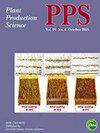两种氮素供应水平下C3和C4禾本科光合氮和水分利用效率
IF 1.3
3区 农林科学
Q2 AGRONOMY
引用次数: 4
摘要
摘要C4植物比C3植物具有更高的光合氮和水分利用效率(PNUE和PWUE)。一些关于C4草的研究报告称,NADP-ME草比NAD-ME草具有更高的PNUE,而其他研究表明,这种差异是由系统发育谱系特征引起的。需要进一步广泛的研究来正确理解C4草的PNUE和PWUE。我们研究了在两种氮供应水平下生长的四种光合类型(4种NADP-ME、6种NAD-ME、6种磷酸烯醇丙酮酸羧激酶(PCK)和6种C3)的22种草的PNUE和PWUE。在相同的氮水平下,三种C4类型表现出比C3类型更高的光合速率、更低的气孔导度和蒸腾速率,但C4类型的这些参数相似。尽管这四种类型的单位面积叶质量和单位叶面积氮含量没有显著差异,但NADP-ME型的这些性状往往比其他类型的略低。结果,PNUE在NADP-ME型中最高,在C3型中最低,在NAD-ME和PCK型中居中。C4类型中的PWUE比C3类型中的高得多,但在C4类型中相似。N供应水平对PNUE和PWUE的趋势没有太大影响。本研究表明,NAD-ME和PCK草具有与NADP-ME草相似但不同的氮相关生理特性。图形摘要本文章由计算机程序翻译,如有差异,请以英文原文为准。
Photosynthetic nitrogen- and water-use efficiencies in C3 and C4 subtype grasses grown under two nitrogen supply levels
ABSTRACT C4 plants have higher photosynthetic nitrogen- and water-use efficiencies (PNUE and PWUE) than C3 plants. Some studies on C4 grasses have reported that NADP-malic enzyme (NADP-ME) grasses have higher PNUE than NAD-malic enzyme (NAD-ME) grasses, whereas other studies have suggested that this difference is caused by the traits of phylogenetic lineage. Further extensive studies are required to properly understand the PNUE and PWUE of C4 grasses. We investigated the PNUE and PWUE for 22 grass species of four photosynthetic types [4 NADP-ME, 6 NAD-ME, 6 phosphoenolpyruvate carboxykinase (PCK), and 6 C3 species] grown under two N supply levels. Under the same N level, the three C4 types showed higher photosynthetic rate and lower stomatal conductance and transpiration rate than the C3 type, but these parameters were similar in the C4 types. Although there were no significant differences in leaf mass per area and N content per leaf area among the four types, these traits tended to be somewhat lower in the NADP-ME type than in other types. As a result, PNUE was highest in the NADP-ME type, lowest in the C3 type, and intermediate in the NAD-ME and PCK types. PWUE was much higher in the C4 types than in the C3 type but similar in the C4 types. The N supply level did not greatly affect the trends of PNUE and PWUE. This study suggests that the NAD-ME and PCK grasses have the N-related physiological traits similar to each other but differing from the NADP-ME grasses. GRAPHICAL ABSTRACT
求助全文
通过发布文献求助,成功后即可免费获取论文全文。
去求助
来源期刊

Plant Production Science
农林科学-农艺学
CiteScore
5.10
自引率
4.00%
发文量
27
审稿时长
>36 weeks
期刊介绍:
Plant Production Science publishes original research reports on field crops and resource plants, their production and related subjects, covering a wide range of sciences; physiology, biotechnology, morphology, ecology, cropping system, production technology and post harvest management. Studies on plant production with special attention to resource management and the environment are also welcome. Field surveys on cropping or farming system are also accepted. Articles with a background in other research areas such as soil science, meteorology, biometry, product process and plant protection will be accepted as long as they are significantly related to plant production.
 求助内容:
求助内容: 应助结果提醒方式:
应助结果提醒方式:


